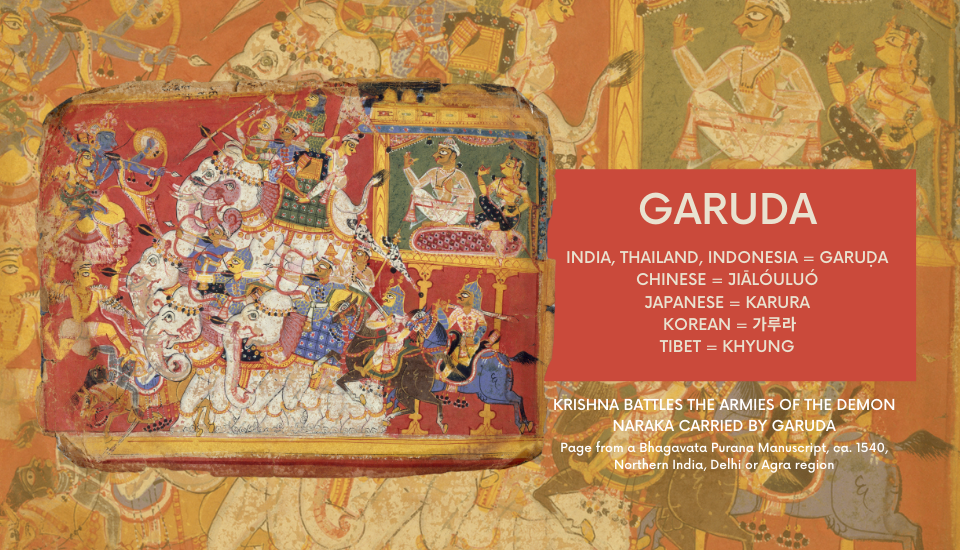
Who is Garuda and what is Garudasana?
Garuda is a character known as the king of birds in the epic tales Ramayana and Mahabharata. In addition, one of the 108 Upanishads is devoted to him, the Garudaupanishad. He fulfils his role as the vehicle that transports Vishnu in varying forms into conflicts and other places. He is shown singularly in the art included in these pages with Vishnu as himself and his avatars Krishna and Varahara the boar.
There is a yoga pose named for him. Most yoga poses are named with Sanskrit words, and Garudasana is no exception combining the words Garuda meaning the devourer and asana meaning posture or pose. Garuda has other similar names depending on various Asian cultures but, we’ll stick with Garuda here.
He takes the form of a predatory bird like an Eagle or Kite in the family Accipitridae. He is depicted with bird legs and claws sometimes and other times with human arms and legs. Birds in this family of Accipitridae are extremely powerful.
An eagle’s senses are keen. Their ears are hidden but powerful. And like human beings, they have a 3D vision with the ability to see forwards and sideways. Their sight is eight times greater than ours. With their ability to fly and soar, they can survey all directions to the North, East, South and West. Eagles can spiral up towards the sky above and down, as well, giving them vast views and perspective with both 2D and 3D visual experience.
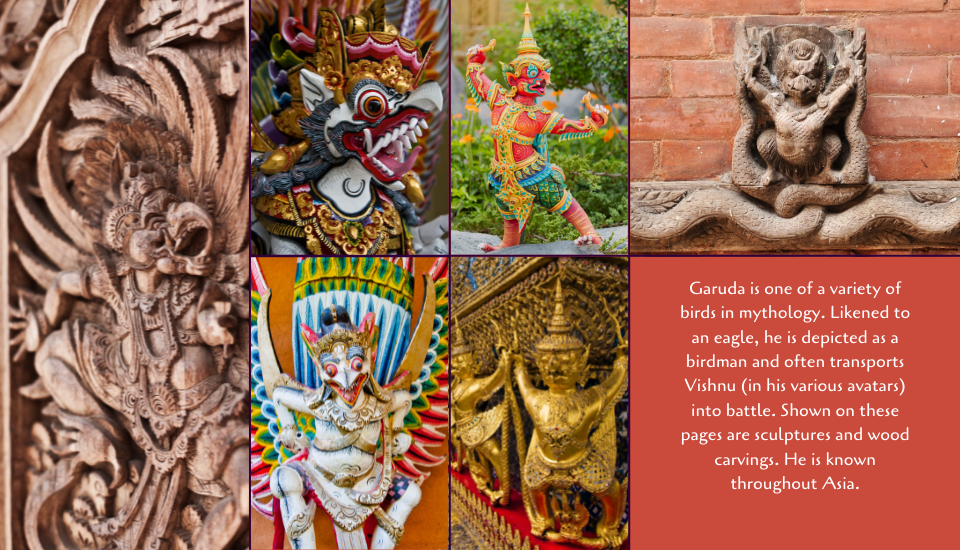
Even though they can swoop, glide, and swirl as winged beings, they grasp and hunt using their toes. Snake eagle’s toes are short and strong allowing them to grasp and hold onto wiggling snakes. Eagles must utilize their clawed feet or they will not survive. They must be able to use the things on the ground and be able to fly. For the eagle, their feet and wings are of equal importance.
Although the sky is a bridge to the vast cosmos, the land and sky belong to one world for the eagle, not separate entities as they can appear, although illusory to us. Their way of being is wholistic.
Enemy of snakes?
Even though he is considered an enemy of snakes, Garuda is described as wearing a variety of snakes AKA Nagas (serpent gods) winding around him as adornments and it’s not just one or two nagas that encircle and entwine him but several. The snakes Padma and Mahapadma adorn his ears and he wears the serpent Karkotaka as a necklace. Shankachuda a serpent adorns his hair like a crown (snake eagles often have crests of feathers upon their head.) That’s not all the mighty Adisesha serpent wraps around his left wrist and the serpent Gulika on his right wrist. The cobra Takshaka winds around his hips like a belt or girdle. The great serpent king Vasuki encircles his body around him to form his sacred thread aka yagyopavita or janeu. Unobstructed by their presence, he moves freely.
The sacred thread is a sash worn across the chest draping from the left shoulder to the opposite hip. It is given to a student during a rite of passage known as Upanayana or Vidyarambha and is a symbolic gesture of their intellectual birth with the care of a teacher.
Other nagas serve Garuda as his servants. And yet, it is believed that he fed only on snakes similar to the short-toed eagle found in India.
Wisdom
Snake eagles swallow snakes whole, symbolic of, and reflecting the ingestion and digesting of a higher wisdom. Apropos, Kundalini, an inherent wisdom resides in all of us. Symbolized as a dormant snake coiled at the base of our spines, when awakened, it forms spiral energy that moves on a spiral path upwards through the crown of our head.


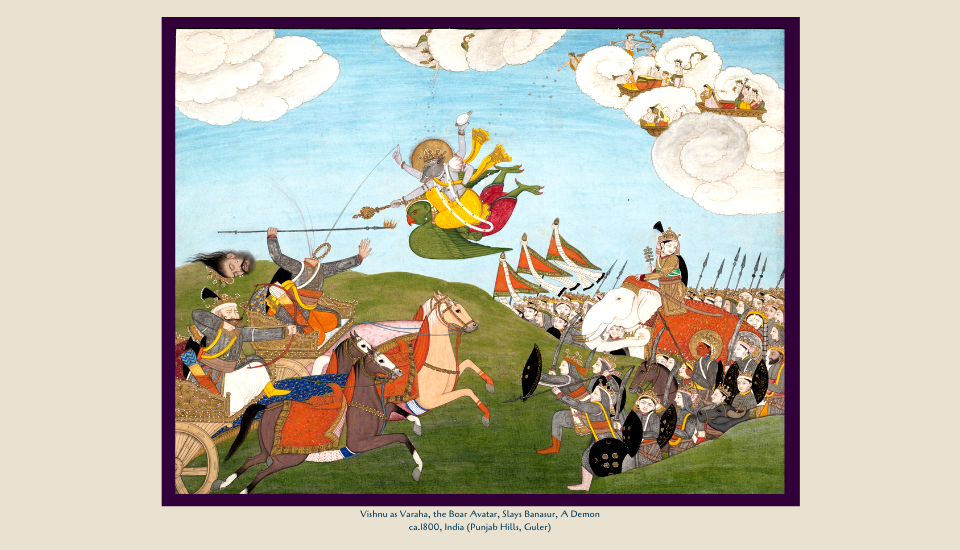
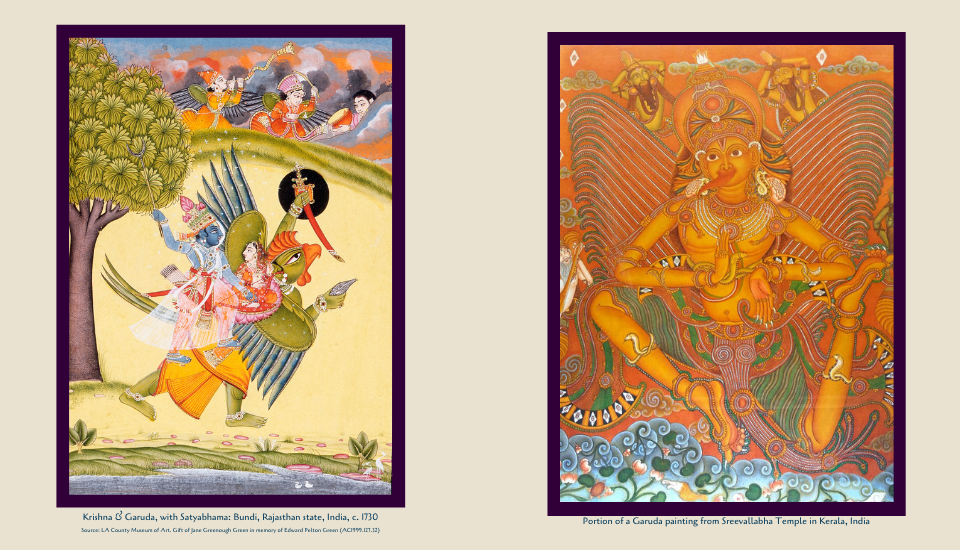
The energy of Garudasana
Garuda often flies towards or into conflict carrying Krishna or Varaha. So, it seemed to me, that if we were to mimic or embody the giant kingbird Garuda in a yoga posture, we would metaphorically spread our wings wide, extending them outward and upward holding them steady to soar, or up and down as if in flight. That isn’t the case. Instead, we raise our arms and then swoop them down with one arm under the other to wrap them.
One reference tells us that our arms become his strong beak. The beak is the hard-shelled protection that always leads us in flight as our energy sores upward, downwards or forward into circumstances. I like the idea of our hands forming the beak, as we maintain balance on one foot as we move deeper into the pose, bending and curling inward with our arms reaching forward.
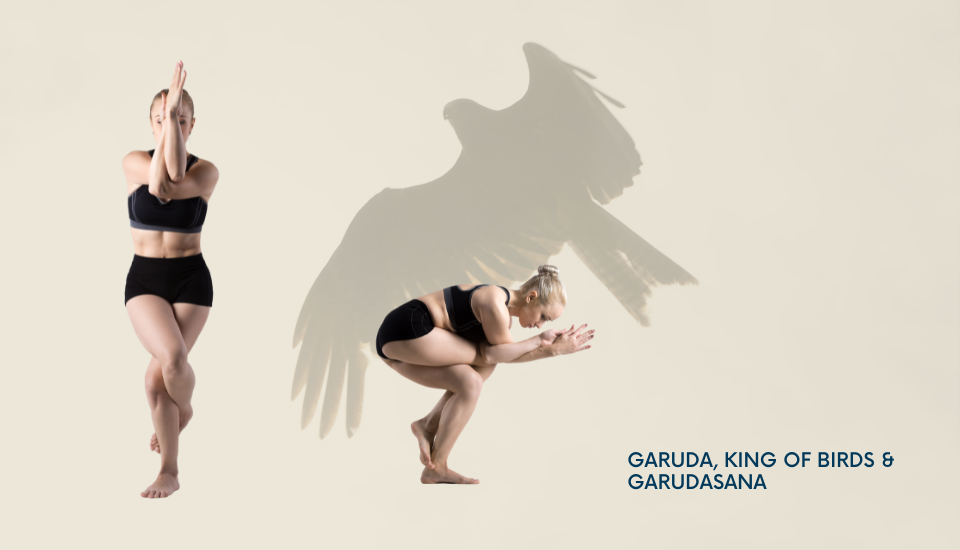
In this pose, the spiral motion and idea of winding and twisting our arms and legs remind me of the snakes that adorn Garuda. However, more likely we are mimicking the eagle ability to soar; We know that eagles use the swirling energy in winds to soar flying upward in a spiral. Spiral energy (helix) exists throughout the natural world in the micro and the macro seen in spiral galaxies including our own Milky Way, and although invisible to the naked eye in the DNA of living creatures on earth. You might notice the tendril of a vining plant reaching and spiralling upwards and outwards as it seeks balance and support. We can ponder any form of this energy as we practise the modern version of the pose winding and wrapping our arms and legs around one another.
The Posture
Eagle pose aka Garudasana is a standing balance pose that helps to loosen up your joints, stretch your muscles and challenge your balance. Each time we work towards finding that balance, we develop determination and strength. We can bring our lessons from the pose into waking life.
The key areas on which this asana focuses are the ankles, calves, thighs, hips and shoulders. As a full-body pose, it can increase your overall fitness. There are various ways you can practice it dependent upon your flexibility and can be very challenging. Don’t be discouraged, yoga always offers variations.

Sidenote: Formerly this pose differed in Hatha yoga. The arms are the same, wrapped together but the legs held differently. The horse pose aka Sanskrit name shown here has the legs and knees lower on the ground. Today it is taught differently.
Arms
From mountain pose, raise your arms with an inhale sweep them down and crossing them in front of you place one arm under your other arm and wrap your forearms and using the hand of your lower arm grasp the other wrist. If it is too difficult to wrap your arms after crossing them, place your hands on your opposite shoulders. In addition to the traditional footing, you can do eagle arms in cow pose AKA Gomukhasana or warrior one AKA Virabhadrasana.
Legs
Keeping your arms in place, start by sitting into chair pose, then lift and cross one leg over the other and begin to wrap your lower leg behind the leg you are balancing on. It will be easier to wrap your lower leg [shin and ankle] around the leg you are balancing on the higher up on your thigh you cross your leg. Don’t worry if you cannot do this in the beginning. Eventually, you will be able to do this.
If you cannot wrap one leg around the other, cross your leg keeping the upper leg’s toes off the ground or setting them down alongside your foot like a bicycle kickstand. If you are struggling to maintain your balance, you can use the wall to support your back. If these options are not attainable for you yet, then keep your knees bent sitting back in chair pose.
Putting it together
Now with your legs in place and your arms wrapped together, push your arms outward and upward. Keep pressing your shoulders away from your ears. Hold the pose for 15 to 30 seconds or hold for 5-10 slow and steady breaths. Then unravel your legs and arms and do the other side.
Another option is to bend from the waist. Your arms will naturally move forward – I mean your beak 🙂 Hold here for a few more breaths before returning to the posture in the upright position and unravelling your arms and legs.
Even though this may look like a difficult posture, by practising it regularly and remaining in this posture for at least 15 to 30 seconds on each side you will progress and reap its benefits.
Benefits of Garudasana
The benefit you obtain from practising this posture is the strengthening and stretching of your calves and your often neglected ankles. Besides, the pull and stretch help your thighs, hips, shoulders and upper back. Of course, when we practice breathing at a nice steady pace not only will your body benefit but your mind and soul too. In the end, you’ll be more relaxed. With relaxation, your level of concentration improves. Although we cannot fly, we can consider other vantage points before taking flight into a battle or any situation. We can also remember that like the eagle that moves between the sky and the land, we are part of the creation not separate from it. When we embody the qualities of Garuda and learn the lessons of this pose – balance, power, perspective, concentration – our power of discernment is enhanced.
———-
Sidenotes on Vishnu:
Vishnu is one of three in a trinity that includes; creator, destroyer and preserver. He is the preserver and helps humans. He is born into the world in various avatars aka forms over the ages. When he accomplishes his mission he disappears from the human world until he is needed again.
Vishnu’s incarnations

Page from a Bhagavata Purana Manuscript, ca. 1540, Northern India, Delhi or Agra region
- Matsya (fish)
- Kurma (turtle)
- Varaha (pig/boar)
- Narasimha (half-lion, half-human)
- Vamana (a dwarf sage with the ability to grow)
- Parasurama (fierce human/hunter)
- Rama (greatest warrior/ideal human)
- Krishna (human with supreme knowledge and happiness)
- Buddha (enlightened human)
Rama and Krishna, are also the subject of the great epic stories of Ramayana and Mahabharata (The Bhagavad Gita is part of the Mahabharata), respectively.
Garuda’s name in various cultures:
- Japan – Karura’ (Sometimes Karura is confused with the Phoenix, and although this creature is associated with fire like the mythological Phoenix, they are not the same.)
- Korea
- Thailand
- Indonesia
- India – Garuda
Symbolism
Garuda is associated with fire and its flame and the Sun; which essentially is a fireball. We met Garuda in the last issue of Mindful Soul Center in the essay on the symbolism of the Sun and Moon where we discussed the Eagle and the Snake. The snake forms a significant part of the symbology across most world cultures, traditions, and religions. Similarly, the eagle does too as every society that had contact with eagles has developed mythology or some form of mysticism around them. Eagles live on all continents except for Antarctica.
- Garuda is associated with fire and its flame and the Sun, which is essentially a fireball.
- Garuda is the national symbol of both, Thailand and Indonesia, with the national airline of Indonesia named Garuda Indonesia.
References:
- Garudaupanishad
- Sanskriti Magazine
- Wikipedia

